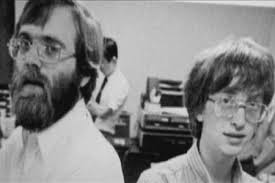The intersection of athletics and computers at the dawn of the World Wide Web was the crux of Donald Katz’s 1995 Sports Illustrated article about Paul Allen attempting to work his Microsoft mindset into the NBA. An excerpt:
Besides the thronelike easy chairs built into the wall along one side of the regulation basketball court and the Santa Fe-style high-desert oil paintings on the opposite wall, the distinguishing features of Allen’s arena are video monitors of the sort that can be seen everywhere on his estate. Each of the screens is electronically tethered to dozens of other monitors and computer systems inside the Allen compound. Simply touching a display on one of the screens can achieve high-speed access to satellites circling the globe and therefore to just about any sports event being broadcast anywhere in the world. Inside his plush 20-seat theater, equipped with a 10-by-14-foot screen,
Allen can view ultra-high-definition video images that less-privileged consumers won’t be able to see for several years. And if Paul Allen must miss a Blazer game because he’s out at sea on his 150-foot yacht, the team will tape the game at a cost of around $30,000 and beam it to him as a digital stream of private entertainment.
From any keyboard inside his home, Allen can also access computers strewn throughout the vast web of his futuristic business empire. He can send E-mail out to Blazer forward Buck Williams or to coach P.J. Carlesimo’s address in cyberspace. “I’m not using these —- computers, and I’m not readin’ no E-mail!” Carlesimo declared upon being presented with his laptop shortly after he was hired by the Blazers last summer. But since then P.J. has seen the light and joined his boss in what Allen has long called ‘the wired world.’ …
Allen, 42 and the 13th-richest American, has lately spent $1.2 billion of his $4.6 billion Microsoft-spawned fortune on a broad array of digital satellites, wireless communications outfits, multimedia software and communications hardware firms, futuristic research companies and high-profile entertainment ventures. Last March, Allen underscored the convergence of Hollywood and the digital media age through his investment of $500 million in DreamWorks SKG, the studio being assembled by Steven Spielberg, David Geffen and Jeffrey Katzenberg. And as Allen’s executives and research scientists work more subtly to merge economic power, advanced technologies and big-time sports, they are similarly defining a future in which the experience of sports will surely be changed.
Down in Portland, Allen’s Trail Blazer organization is managing the construction of a $262 million sports arena called the Rose Garden, which will be strewn with computers and wired with miles of fiber-optic cable. The 70 luxury suites inside the Rose Garden will be equipped with teleconferencing gear and be fed channels full of computer-generated sports statistics. The concourses of the Rose Garden will be draped with glowing video screens, and Allen eventually wants to feed stats and replays and stock quotes and weather reports and images of games being played in other places to a tiny screen located at every seat.
Not unlike other team owners who have invested in new stadiums and arenas over the past year, Allen is considering a virtual-reality entertainment center next door to the Rose Garden. An official Blazer “home page” already connects on-line fans to the team’s own Internet address. The Blazers’ staff includes a seasoned multimedia software developer assigned to create sports products that the Blazers can sell to other teams. “My mission,” team president Marshall Glickman proclaimed early in this past NBA season, “is to integrate Paul Allen’s world of computers and communications with my own world of sports.”
During the ‘information superhighway’ media frenzy that began toward the end of 1993, a Seattle Times reporter imagined a day in the not-too-distant future when a fan who got home late during a Seattle SuperSonic game could digitally fast-forward through the recorded action until he caught up with the real-time telecast. After a Shawn Kemp dunk, the reporter presumed, the viewer could click on the image of Kemp and call up his latest stats, read stories about Kemp from newspapers all over the world or connect with the Shawn Kemp Fan Club in Indiana. Another click would automatically order Shawn Kemp souvenirs or tickets to a coming Sonic game. The viewer could change the camera angle from which he or she was seeing the game, focusing on Kemp or watching the action from overhead.
And all of this, the newspaper article pointed out, could occur within the boundaries of Allen’s multimedia portfolio. “Once the high-speed digital channel is wired into people’s houses,” Allen says before finally nailing a three-point basket, “all of that– and more — becomes pretty easy to do.”
Early evidence indicates that many of the innovations now understood only by technologists like Allen will intensify our experience of spectator sports — just as audio CDs have enhanced the secondhand experience of a live symphony. The informational and visual options available to fans sitting at home or in the stands are already multiplying as sports become proving grounds for advanced digital technologies. But these technologies also raise a broad array of questions, from immediate concerns (Will computerized gambling soon be inextricably linked with big-time sports?) to new business issues (Will people pay for new services?). Then there are longer-term issues: Will computer-based technologies someday offer sportslike entertainment so enthralling and convenient and highly customized that games created from bits of the best of real sports and bits of the best sports fantasies render live games obsolete?•
Tags: Donald Katz, Marshall Glickman, Paul Allen



